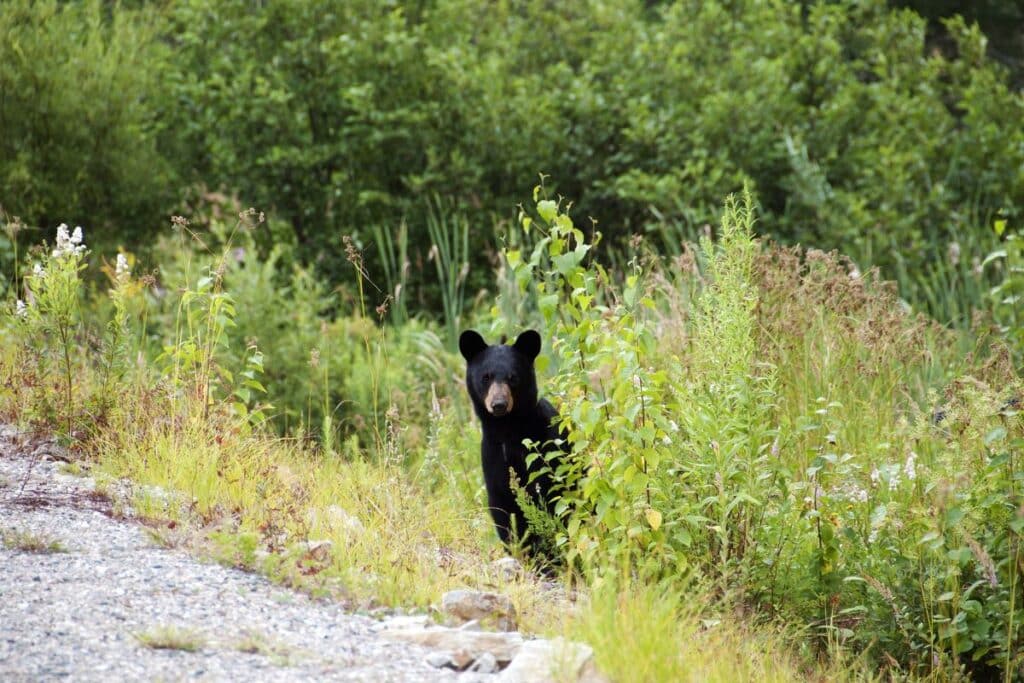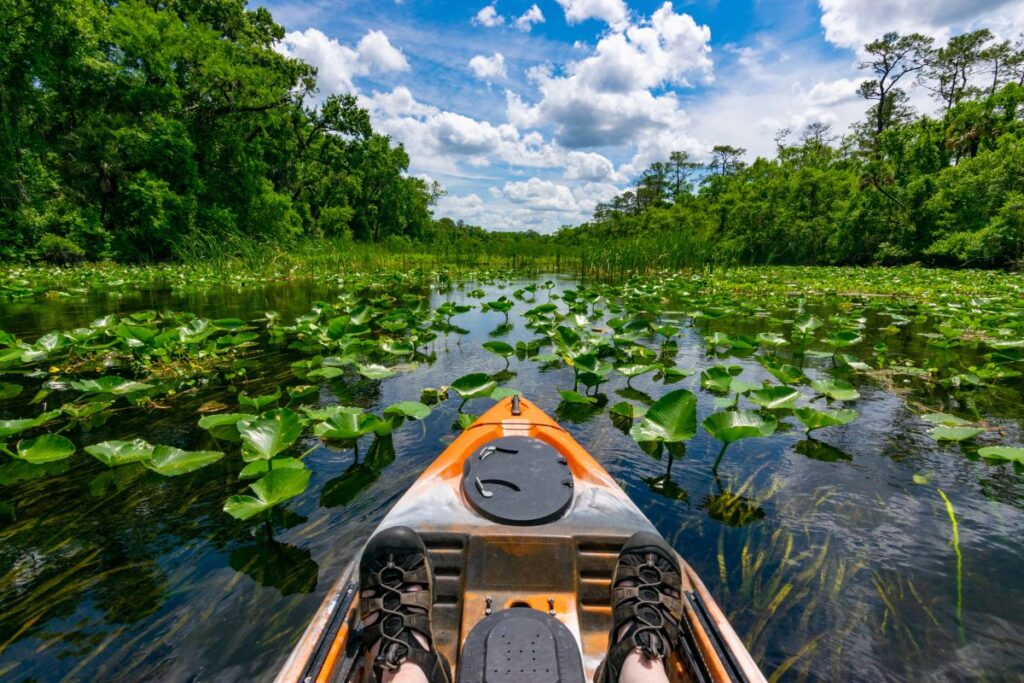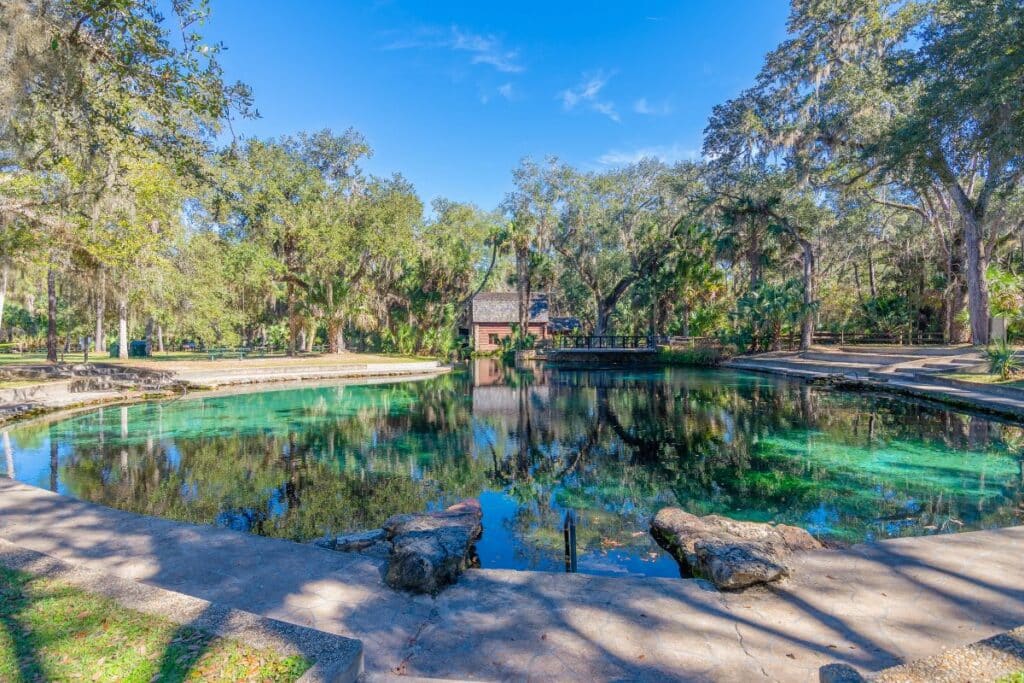Discover 17 amazing animals in Ocala National Forest! From black bears to alligators, join our journey through Florida's wilderness. Tips & photos included.
Venture into Ocala National Forest, Florida’s captivating expanse where wildlife plays amidst nature’s untouched beauty.
On our recent journey through this lush terrain, we were fortunate to witness a myriad of creatures, from sun-soaked alligators to the elusive Florida black bear.
Imagine the allure of hearing a wild turkey’s gobble resonate through the dense woods, or the thrill of spotting a creature you’ve only read about.
In the following segments, we’re detailing our top 17 animal encounters and answering your curious questions about the diverse inhabitants of Ocala National Forest.
Ready? Join us on this enlightening journey through one of Florida’s most enchanting wildernesses!
Florida black bears
The Florida Black Bear (Ursus americanus floridanus) is a unique subspecies of the American Black Bear. Adult bears display a sleek, black coat with a tan muzzle and sometimes a white chest patch.
Males typically weigh between 250 to 450 pounds, whereas females are smaller, averaging 130 to 250 pounds.
Their keen sense of smell, strong limbs, and sharp claws make them adept climbers and swimmers.
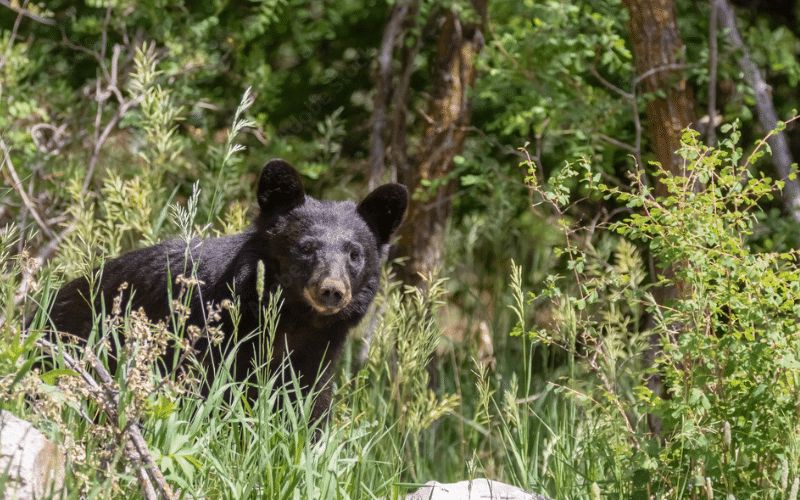
Ocala National Forest serves as a significant habitat for the Florida Black Bear. These bears primarily reside in the forest’s dense scrub and hardwood swamps.
Key areas to possibly spot them include the Juniper Springs and Alexander Springs areas. They also frequent places with abundant food sources, especially during berry season.
If you’re keen on observing these magnificent creatures, consider exploring the Bear Swamp Trail or the Yearling Trail. While there’s no guarantee of a sighting, these trails traverse through prime bear territories. Remember to tread lightly; the forest is their home.
These bears are omnivores, meaning they eat both plants and animals. Their diet consists mostly of fruit, nuts and insects, but they will also eat rodents, birds and eggs if they find them available. They rarely attack humans unless provoked or protecting their young.
Safety First: While Florida Black Bears are generally not aggressive, it’s essential to maintain a safe distance. Never approach or attempt to feed them.
Bear-Proofing: If you’re camping, make sure to store your food in bear-proof containers or hang it high up in a tree, away from a bear’s reach.
Awareness: Bears, especially mothers with cubs, can be protective. If you stumble upon cubs, be cautious as the mother is likely nearby.
Crossings: Ocala has several bear crossings. These are marked areas where bears frequently cross roads. Drive with care, especially around dawn and dusk.
Alligators
Alligators are an incredible part of Florida’s history and culture.
Sporting a robust, elongated body covered in armored scales, adult alligators can range from 10 to 15 feet in length, with males generally being larger.
Their powerful tails, used for swimming, make up nearly half their length. Their coloration, typically dark gray or black, aids in their stealthy hunting tactics and in absorbing heat from the sun.
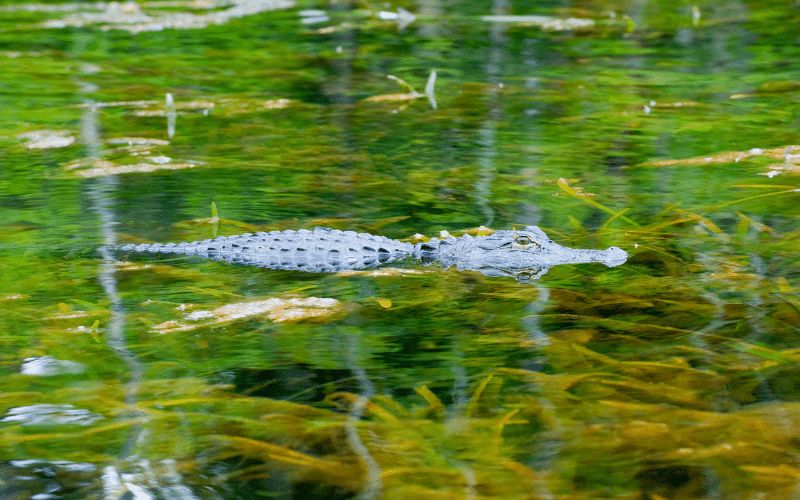
Ocala National Forest’s vast network of freshwater springs, rivers, and swamps provides the perfect habitat for alligators.
These reptiles can often be found sunbathing along the shores of the Silver Glen Springs and Salt Springs. On warmer days, it’s not uncommon to spot them floating or submerged, with just their eyes and nostrils above water.
For enthusiasts eager to observe alligators in their natural surroundings, the Salt Springs Observation Trail and the Silver River Paddling Trail are excellent choices. These trails provide glimpses of alligators while ensuring visitor safety.
Safety Precautions: Always maintain a safe distance. Alligators, though usually passive, can move surprisingly fast when provoked.
No Feeding: Feeding wild alligators is illegal and dangerous. It alters their natural behavior and may associate humans with food.
Pets and Children: Keep pets and young ones close and supervised. It’s advisable not to let dogs swim in waters known for alligator presence.
Respect the Habitat: When kayaking or canoeing, avoid approaching nesting sites or young alligators. Mothers are protective and might perceive you as a threat.
Ocala National Forest allows you to witness the grandeur of alligators in their pristine environment. By adhering to guidelines and maintaining respect, visitors can enjoy a memorable and safe experience.
Coyotes
The coyote’s slender form is a silhouette of agility against Ocala’s sprawling landscapes.
Cloaked in a versatile coat, colors dancing between grays to earthy browns, it boasts keen eyes reflecting a world of cunning.
Pointed ears atop its head and a bushy tail trailing behind make it unmistakable, even in brief encounters.
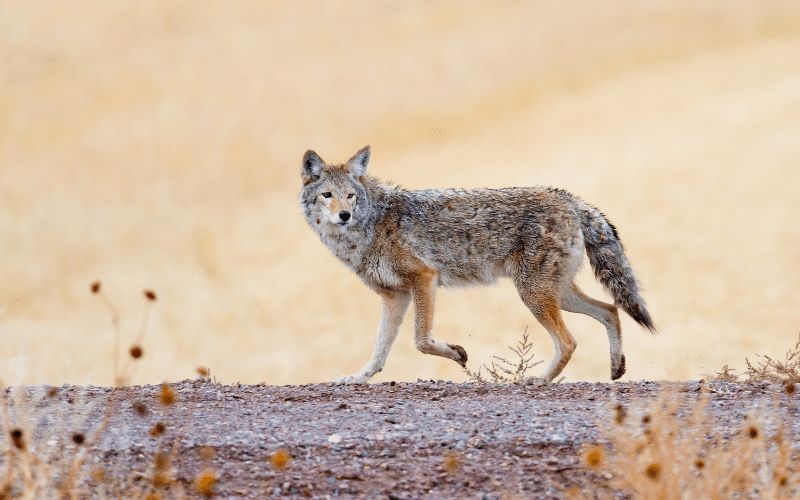
Coyotes are omnivores which means they eat both plants and animals. Their diet varies depending on what is available in their habitat but can include insects, fruit, berries, rodents, reptiles, birds, eggs and even small deer!
The vast grasslands and shadowy woods of Ocala are the coyote’s playground. As the sun dips below the horizon or emerges from its slumber, their haunting howls might resonate, painting an aural picture of the wild.
Adventurous souls exploring the trails of Piney Island or immersing themselves in the Black Bear Wilderness Loop might just cross paths with these embodiments of wilderness.
Coyotes, despite their reputation for solitude, can occasionally exhibit pack behavior.
What’s even more fascinating is their ability to adapt to diverse habitats, ranging from open prairies to dense forests and even urban environments, making them one of North America’s most adaptable mammals.
White-tailed deer
Gracing the dense woods of Ocala with elegance are the White-tailed Deer. Their coats, reddish-brown turning to muted gray in winter’s embrace, ripple as they move.
The bucks, with their majestic antlers, stand as a testament to nature’s artistry, especially during the shedding and regrowing phases, a cyclical dance of nature.
When morning dew still clings to the grass or as twilight begins its descent, meadows and clearings in Ocala become stages for these gentle herbivores.
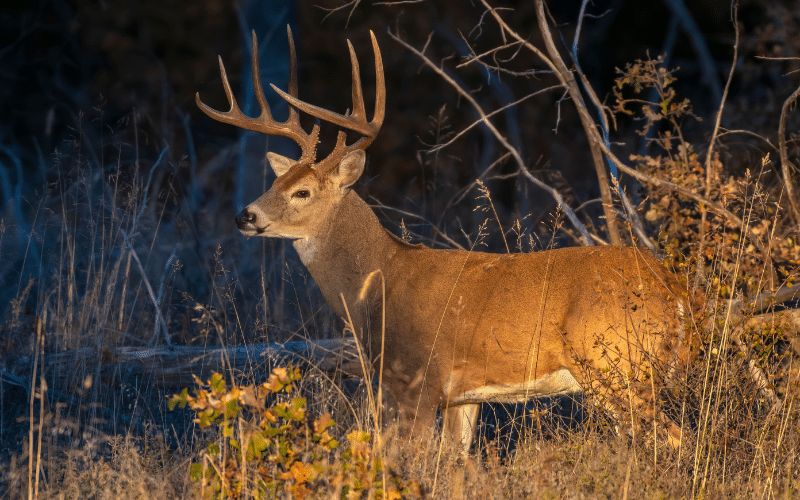
For those whose steps wander through the Big Scrub Campground Loop or the nooks and crannies of the Florida National Scenic Trail, a serene encounter with these deer is a gift of the wild.
The white underbelly and tail of these deer aren’t just for show. When alarmed, they raise their tail, displaying its white underside, signaling a warning to other deer nearby.
This simple act, often seen during a hasty retreat, has given them their iconic name.
Wild boar
Ocala National Forest is a beautiful place to visit, but it is also a great place for wild boars. Wild boars are native to Florida and have been seen roaming the state for hundreds of years.
The wild boar, with its robust build and coarse, bristled coat, brings an air of rugged wilderness to Ocala National Forest.
Often displaying a mix of colors ranging from dark brown to gray or even black, their sharp tusks and pointed snout hint at their wild lineage and adaptability.
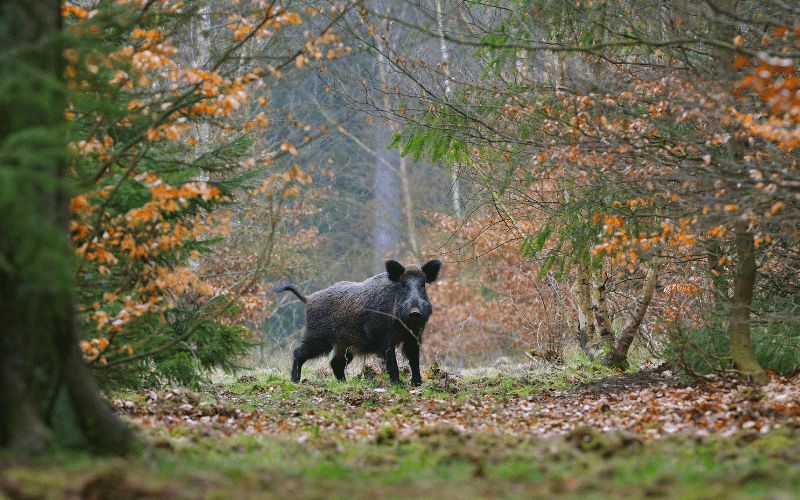
Ocala’s thickets and dense underbrush provide the ideal sanctuary for these creatures. They are often seen rooting around in the mud, foraging for food with their keen sense of smell.
For travelers and nature enthusiasts traversing Ocala’s scenic routes, the Mill Dam Recreation Area and parts of the Yearling Trail offer opportunities to observe the wild boar in its natural habitat.
While often seen as aggressive, wild boars are inherently shy creatures. However, they can become territorial, especially when they sense a threat to their young, showcasing a fierce side to their usually calm demeanor.
Squirrels
The squirrels in Ocala National Forest FL are a very unique species. They have adapted to the forest over many years and are now a part of its ecosystem.
As you walk through the forest, you may see them running up and down trees or hiding in your favorite spot for picnics.
The agile and ever-curious squirrel is a delightful sight within the vast expanse of Ocala National Forest.
Their slender bodies, covered in soft fur that ranges from gray to reddish-brown, and their bushy tails, often tell tales of swift climbs and daring leaps amidst the treetops.
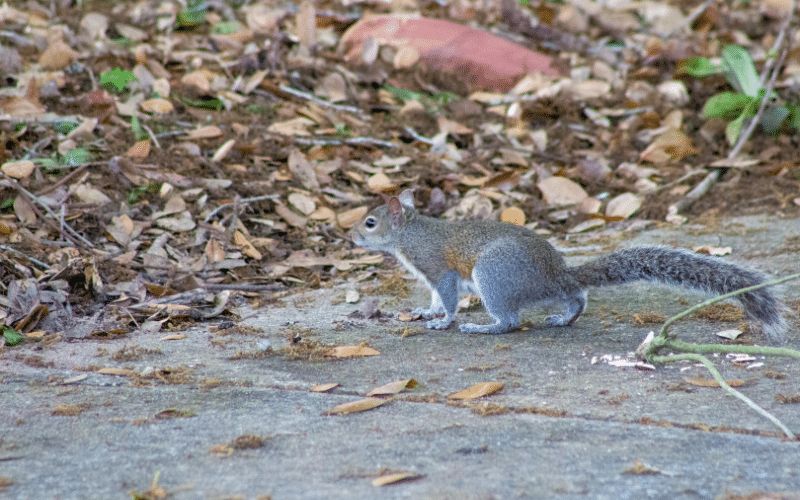
They have adapted their eating habits to include nuts and acorns, which they store in their burrows during the winter months when there is no food available.
These little acrobats find their playground in Ocala’s dense canopies, scampering along branches and darting up and down tree trunks.
For those looking for a charming spectacle, the lush environments around the Alexander Springs Recreation Area or the trails around Farles Prairie are places where squirrels often showcase their playful antics.
Squirrels have an impressive memory. They bury nuts in various locations and can retrieve them months later, an adaptation that not only ensures their survival during leaner times but also aids in forest regeneration as they inadvertently plant seeds in their forgetfulness.
Gopher tortoises
Gopher tortoises are omnivores that eat insects and plants. They feed on grasses, fruits and flowers in summer and dry leaves in winter.
They also eat the roots of plants like wild onions or thistles; this helps control pests in those plant communities.
The Gopher Tortoise, a keystone species, is a testament to the ancient and steady rhythms of nature. With their sturdy, domed shells that range in color from gray to brown, and strong, stumpy legs made for digging, they are nature’s adept excavators.
These tortoises are crucial to their environment, as their burrows provide refuge for over 350 other species.
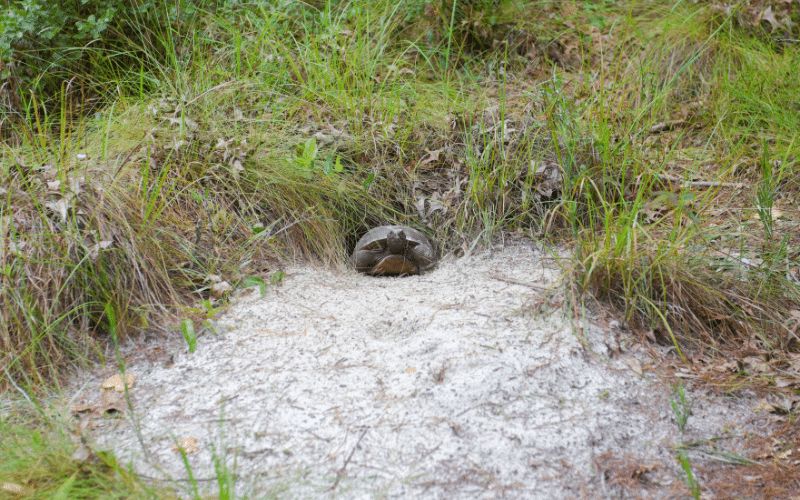
Ocala’s sandy soils and open pine forests make it an ideal home for these gentle reptiles.
The Clearwater Lake Recreation Area and parts of the Paisley Woods Bicycle Trail in Ocala are where you might chance upon a Gopher Tortoise, slowly making its way or working on its burrow.
Despite their slow demeanor, they can dig burrows that extend up to 40 feet in length, making them one of nature’s most industrious architects.
Bats
The Ocala National Forest is home to a wide variety of wildlife, including bats. There are three species of bats in the Ocala National Forest: the eastern pipistrelle, northern long-eared myotis and southeastern myotis.
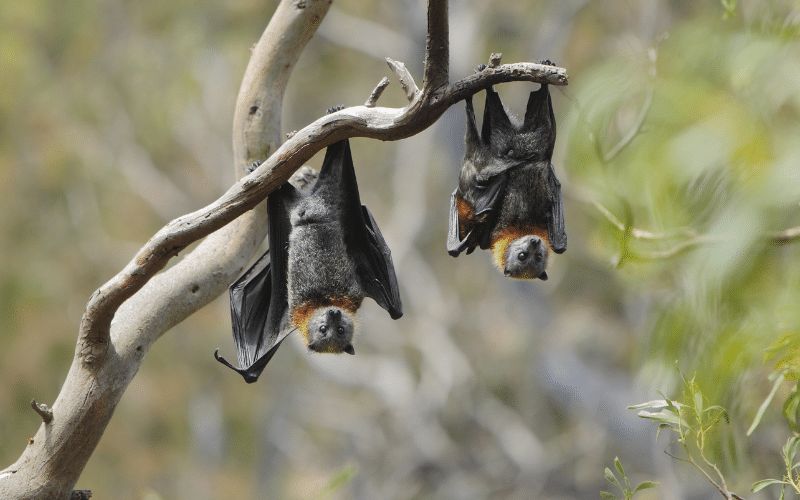
Bats are helpful because they eat insects that can be harmful to humans and other animals. The Ocala National Forest has an ongoing research project to learn more about bats and what they do in the forest.
The forest’s caverns and old trees provide ideal roosting spots for these creatures. As dusk blankets Ocala, areas near the Juniper Springs or along the Salt Springs Run become a theater for their twilight dance, as they emerge in search of insects.
A fascinating fact about bats: Some species can consume up to 1,200 mosquitoes in an hour, making them an invaluable asset in controlling pest populations.
River otters
The Ocala National Forest is home to many types of wildlife, including river otters. The river otter is an agile swimmer that can dive deep into water when searching for food.
River otters feed on crayfish and fish, but they also eat frogs, snails and mussels. When foraging for food, a river otter will dive to depths of 20 feet or more in search of prey items.
Sleek, playful, and agile, the River Otter brings a splash of joy to Ocala’s freshwater habitats.
With streamlined bodies, dense fur that ranges from brown to a more golden hue, and a palpable sense of curiosity, they are a delight to observe.
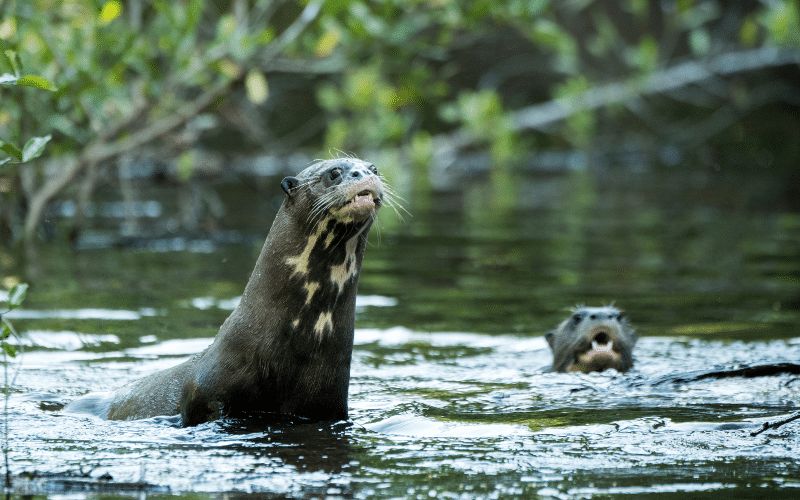
Ocala’s pristine springs and rivers, like the Silver Glen Springs or the Alexander Springs Run, often resonate with the playful splashes of these otters.
They glide through the waters with grace, often seen frolicking or hunting for fish.
Here’s a delightful nugget: River Otters have a set of whiskers that are incredibly sensitive, allowing them to detect the movement of prey in murky waters, showcasing nature’s impeccable design.
Bobcats
In the shadowed realms of Ocala National Forest, the elusive bobcat moves with a silent grace that belies its predatory prowess.
Medium-sized with tufted ears, a ruffed face, and a short “bobbed” tail, the bobcat sports a coat of varying colors – from tawny browns to grays, often adorned with faint spots and stripes.
These markings allow them to blend seamlessly into the dense underbrush and woodlands, making them adept ambush hunters.
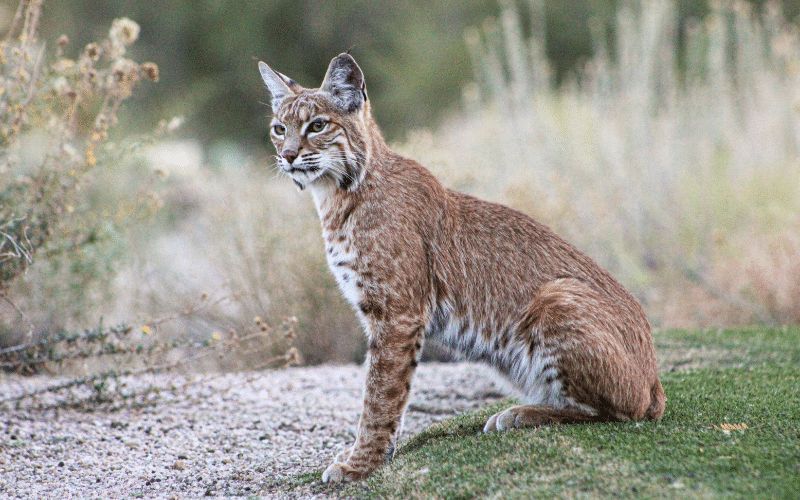
Ocala’s diverse habitats, from its thickets to open grasslands, provide the perfect backdrop for the bobcat’s life dramas. While they are solitary and primarily nocturnal, early morning or dusk near areas like the Farles Prairie or the Juniper Prairie Wilderness might afford you a rare sighting of this feline silhouette.
Did you know that bobcats are incredibly territorial? They mark their domains with scent markings, ensuring a clear message to any interlopers.
Moreover, despite their size, they are formidable hunters, capable of taking down prey much larger than themselves, showcasing the wild’s raw and untamed spirit.
Exploring Ocala National Forest with an eye out for the bobcat can be a rewarding experience, reminding us of the wild wonders that still roam free in our world.
Bald Eagle
With a striking contrast of deep brown feathers and a brilliant white head and tail, the Bald Eagle is a testament to nature’s majesty.
Their immense wings, often stretching over seven feet, lend them a grandeur that few birds can match. These powerful raptors, with their piercing yellow eyes and formidable hooked beaks, are symbols of both grace and strength.
In Ocala National Forest, the vast skies and water bodies, teeming with fish, make it an inviting habitat for Bald Eagles. As they soar high, riding the thermals, their presence becomes a sight to behold.
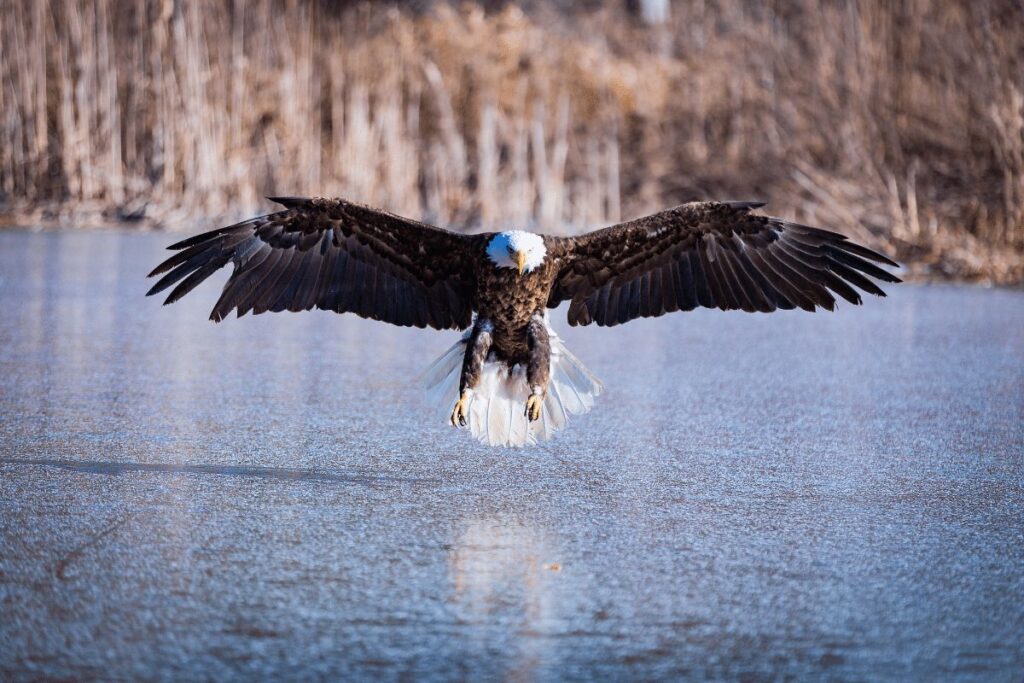
Lakes like Dorr and the environs around Salt Springs are among the places in Ocala where one might catch a glimpse of these avian wonders.
Additionally, the forest trails often offer vantage points where the keen-eyed might spot these eagles either nesting or in pursuit of prey.
One of the most captivating aspects is their nesting behavior. Known to construct some of North America’s largest bird nests, these eagles showcase an architectural marvel. S
ome nests, especially those added to year after year, can weigh an astonishing thousand pounds or more.
Walking the trails of Ocala National Forest, the possibility of witnessing a Bald Eagle in its natural habitat adds an exciting dimension to the journey, making it not just an exploration of the terrain but a brush with America’s iconic bird.
Florida Scrub Jay
The Florida Scrub Jay, with its vibrant blue plumage and curious demeanor and a distinctive sight in Ocala National Forest’s.
Unlike its woodland relatives, this particular jay prefers Florida’s scrub habitats, characterized by sandy soils and low-growing vegetation. Its strikingly blue body, offset with a grayish neck and underparts, makes it easily recognizable for bird enthusiasts and casual observers alike.
Ocala National Forest, with its diverse terrains, offers pockets of scrubby flatwoods and sand pine scrubs which are the preferred haunts of the Florida Scrub Jay.
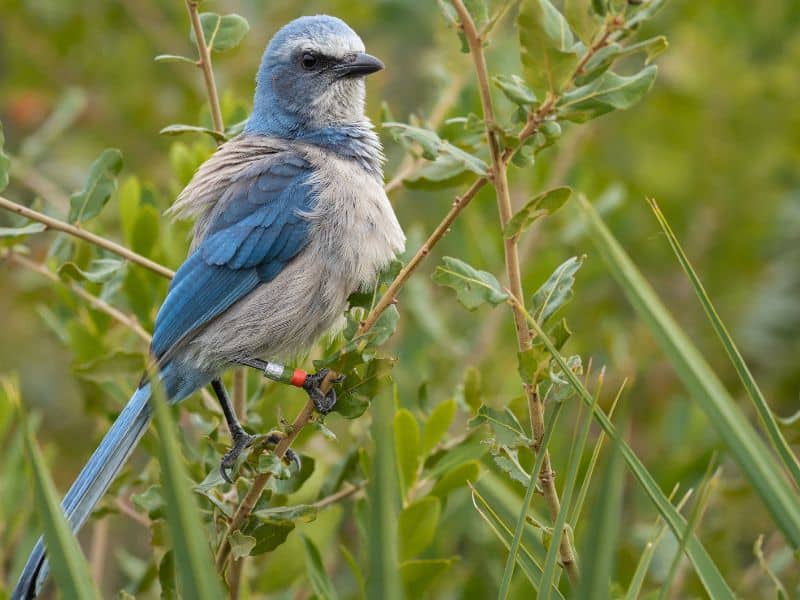
For those traversing the trails of Ocala, places like the Juniper Creek area or parts of the Yearling Trail might offer a delightful encounter with these vivacious birds, as they hop about or engage in their melodious calls.
But what makes the Florida Scrub Jay truly intriguing is not just its beauty but its unique behaviors. Known for their cooperative breeding, these birds often have non-breeding helpers that assist the main breeding pair in raising the young.
Furthermore, unlike many bird species, the Florida Scrub Jay is known to be sedentary, often spending its entire life within a few kilometers of its birthplace.
As one explores the expansive Ocala National Forest, the occasional fluttering of blue or a distinctive call from the shrubs serves as a reminder of Florida’s unique avian offerings, of which the Florida Scrub Jay stands proudly emblematic.
Barking Treefrog
A symphony of calls often fills the air in the Ocala National Forest, and among those melodies is the distinctive croak of the Barking Treefrog.
Named for its resonant, bark-like call, this amphibian is a vibrant member of Ocala’s diverse ecosystem.
The Barking Treefrog’s robust physique, boasting shades of green that can sometimes shift to mottled grays or yellows, is adorned with dark, irregularly shaped spots. Its rounded toe pads help it grip and clamber up vegetation with ease.
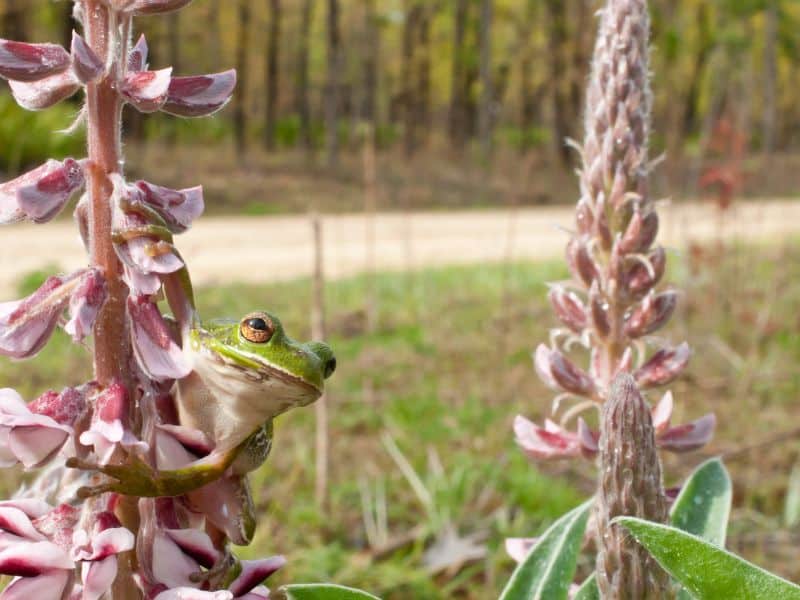
The forest’s wetland areas, with their myriad of ponds, marshes, and shallow waters, provide a sanctuary for these frogs. As one wanders the trails, places like the Hopkins Prairie or the edges of the Farles Lake might echo with their distinctive calls, especially after rainfall or during humid nights.
What’s intriguing about the Barking Treefrog is its adaptability. While primarily arboreal, during dry spells, these frogs are known to burrow into the ground to maintain their moisture, emerging after the rain to revel in the wet surroundings and resume their nightly serenades.
Navigating the trails of Ocala National Forest, the echoing croaks and sporadic sightings of the Barking Treefrog is a testament to the intricate web of life the forest harbors, each species playing its unique tune in nature’s grand orchestra.
Red Foxes
In the intricate mosaic of Ocala National Forest, the Red Fox is a vibrant brushstroke of wild beauty.
This creature, adorned in its rust-colored coat complemented by a white underbelly and a characteristically bushy tail often tipped with white, traverses the landscape with a blend of agility and intrigue.
Keen eyes and sharp ears always on alert, the Red Fox is adept at foraging, whether it’s seeking out berries, hunting insects, or pursuing small mammals.
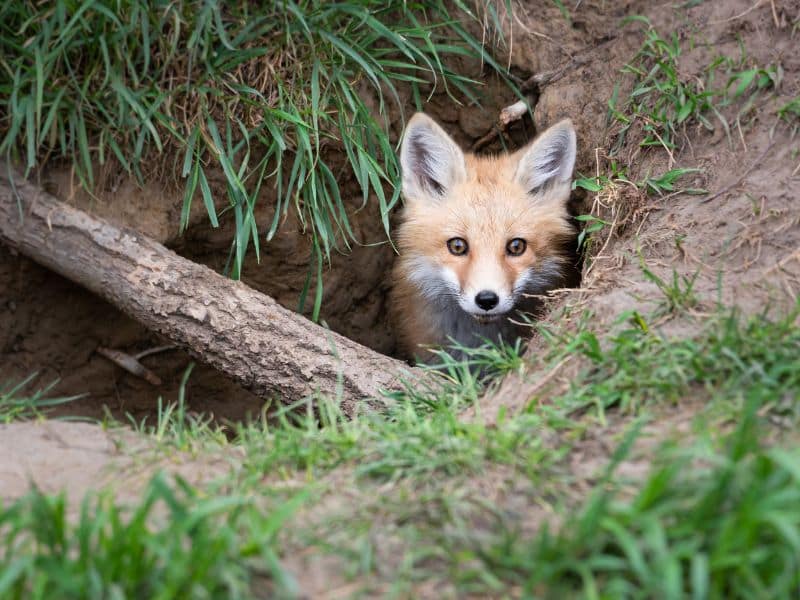
The denser woodlands and open clearings of Ocala provide the backdrop for its daily escapades. For those navigating trails like the Salt Springs Loop or areas around Hidden Pond, a chance sighting of a Red Fox, especially in the subtle glow of twilight, becomes a cherished memory.
Interestingly, the Red Fox has a wide array of vocalizations, from mysterious barks to eerie screams, used for varied purposes from communicating threats to signaling mating intentions.
Ospreys
High above Ocala National Forest, the Osprey reigns, a testament to nature’s aerial mastery.
Distinguished by its sharp, hooked beak, contrasting plumage of white underparts and dark brown back and wings, and a characteristic eye stripe, it is a marvel to observe.
This raptor’s expertise lies in fishing; with sharp talons designed for precision, it plunges into water bodies, emerging with its aquatic prey held firmly.
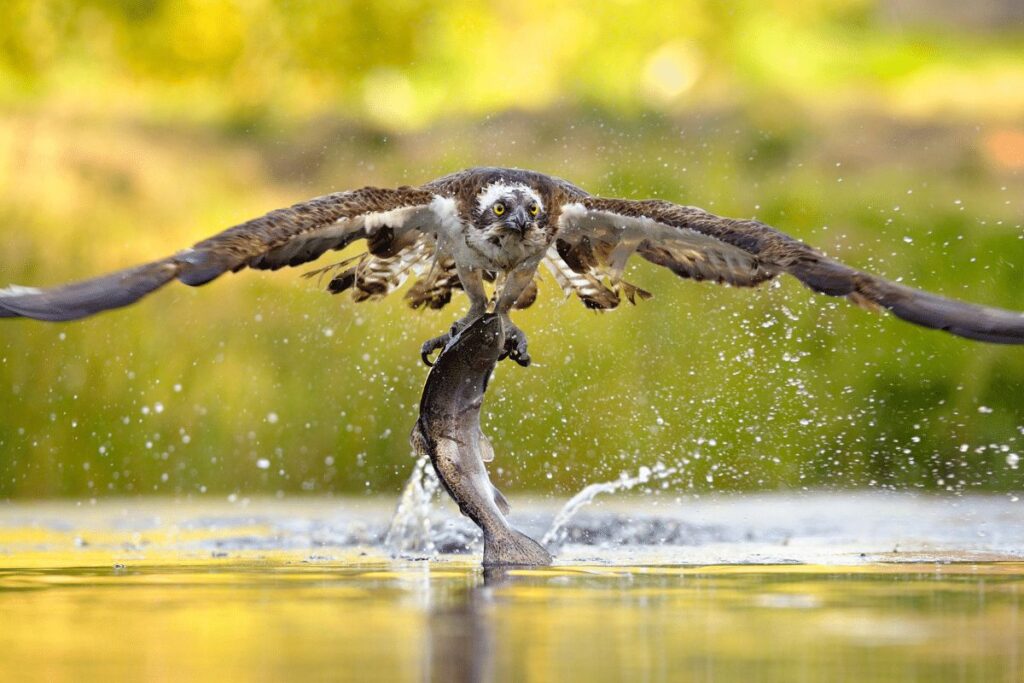
Ocala’s abundant lakes, springs, and rivers serve as the Osprey’s hunting grounds. Places like Silver Glen Springs or the expansive Lake George frequently become theaters for the osprey’s dramatic fishing expeditions.
A captivating aspect of the Osprey’s anatomy is its unique reversible outer toe, enabling it to hold its catch with two talons positioned in front and two behind, ensuring a firm grasp on slippery fish.
Raccoons
Raccoons are a common sight within the vast expanses of Ocala National Forest. With their characteristic black-masked faces and bushy striped tails, they easily stand out amidst the dense foliage and vibrant wildlife.
Their clever fingers are not just for climbing trees; they’re adept at manipulating objects and are often seen “washing” their food in water, a unique behavior that’s long captured the interest of naturalists.
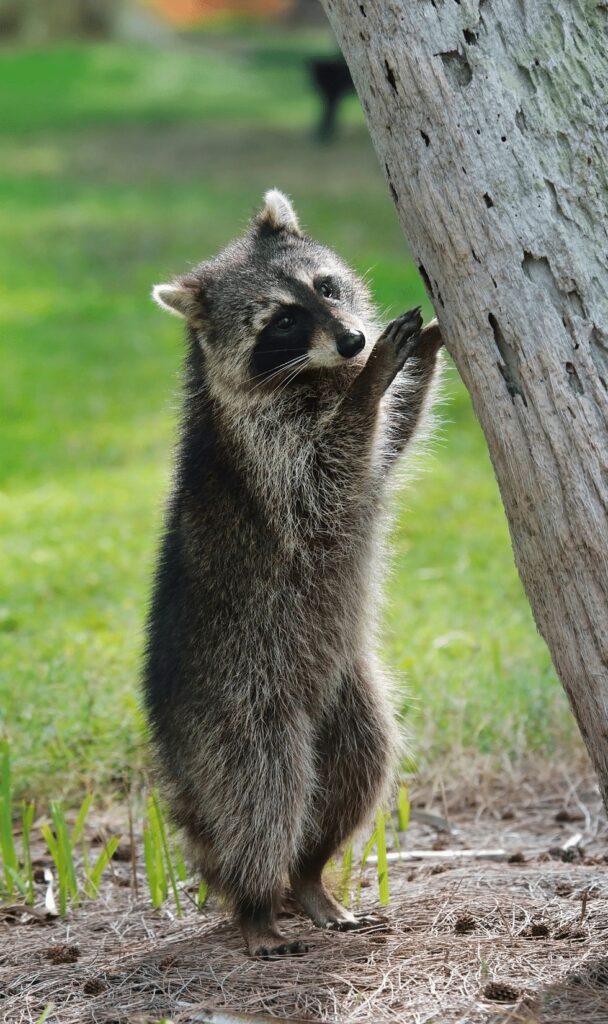
If you’re exploring Ocala, particularly around areas like Alexander Springs or near the Lake Eaton Sinkhole, you’re likely to encounter these creatures, especially during the quieter hours of dawn or dusk.
The trails around these areas often show signs of their nocturnal activities, from overturned rocks to small dug-up patches in search of insects or vegetation.
An interesting fact about raccoons is their adaptability. These resourceful animals have a broad diet and can thrive in various environments, from dense forests to urban areas, showcasing their incredible resilience and versatility.
Red-cockaded Woodpecker
The Red-cockaded Woodpecker is a standout presence in Ocala National Forest. At first glance, its black and white patterned body draws attention, and the male bird’s small red streak near the eye further distinguishes it.
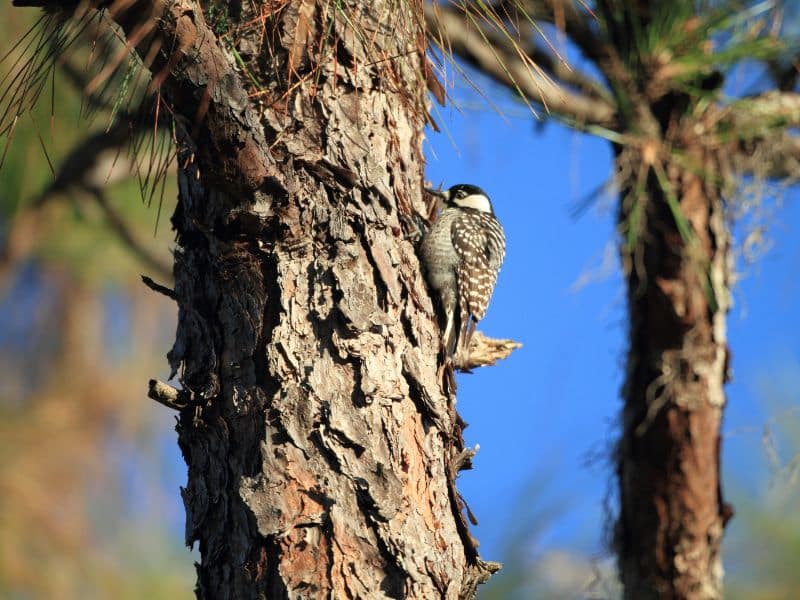
Favored spots for these woodpeckers include the longleaf pine woods, so if you’re wandering through the Big Scrub area or following the Piney Island Trail, listen closely for their rhythmic drumming against tree trunks.
These woodpeckers are not just skilled at finding food; they have the unique habit of creating cavities in living pine trees for nesting.
Unlike most solitary nesting birds, Red-cockaded Woodpeckers often have a communal touch to their breeding. Some birds in the group delay their personal breeding activities to assist others in raising their offspring.
This cooperative behavior, combined with their distinctive appearance and habitat preferences, makes them a fascinating subject in the avian world of Ocala.
Exploring Ocala National Forest’s Wildlife on Hiking Trails
One of the best ways to immerse yourself in the diverse wildlife of Ocala National Forest is by exploring its many scenic hiking trails. With over 600 miles of trails weaving through various ecosystems, you’ll have plenty of opportunities to observe the forest’s inhabitants up close.
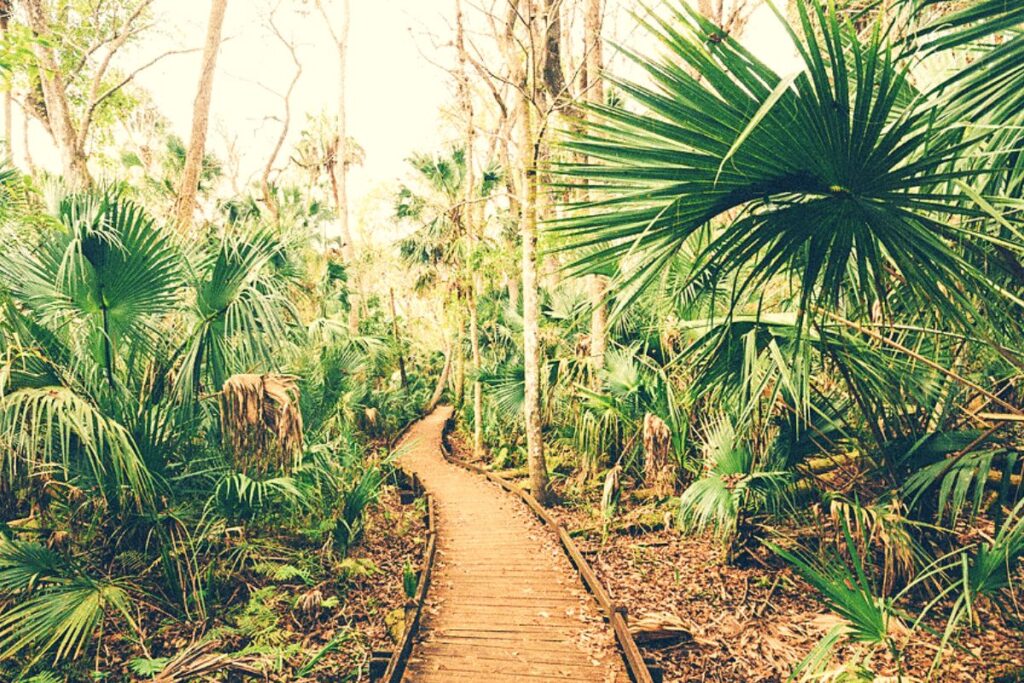
Some popular trails include the Florida National Scenic Trail, which traverses the entire length of the forest, and the Yearling Trail, where you can retrace the steps of Marjorie Kinnan Rawlings’ famous novel. For a more leisurely hike, the Salt Springs Observation Trail offers a chance to spot manatees and other aquatic creatures.
To make the most of your Ocala National Forest adventure, check out our comprehensive guide on Ocala National Forest hikes that covers everything from trail descriptions to difficulty levels and essential tips for a safe and enjoyable experience. Happy hiking!
10 Tips to Spotting Wildlife in Ocala National Forest
- Dawn and Dusk Timing: Wildlife is often most active during the cooler hours of dawn and dusk. Consider setting out early or staying out a bit late to increase your chances of encounters.
- Quiet Movement: When exploring the forest, move slowly and quietly. Avoid loud conversations, and consider wearing soft-soled shoes to minimize noise.
- Trail Choices: Some trails are more frequented by wildlife than others. In Ocala, trails like the Yearling Trail, Juniper Creek Trail, and those near Alexander Springs often offer good wildlife sighting opportunities.
- Stay on Designated Paths: While the urge to go off the beaten path can be tempting, staying on designated trails minimizes disturbance to wildlife habitats and also ensures your safety.
- Use Binoculars: Carrying a pair of binoculars can greatly enhance your viewing experience, allowing you to spot and observe animals from a respectful distance.
- Research Local Wildlife: Familiarize yourself with the species native to Ocala. Knowing what to look for, and understanding their habits and habitats, can significantly improve your chances of sightings.
- Respect Nesting Areas: Especially during breeding seasons, areas where birds like the Red-cockaded Woodpecker nest should be approached with caution. Disturbing these areas can be detrimental to the species.
- Look for Water Sources: Animals often congregate around water sources. Venturing near freshwater springs or lakes in Ocala, like Silver Glen Springs or Lake Dorr, can be rewarding.
- Attend Guided Tours: Ocala National Forest occasionally offers guided wildlife tours or educational programs. Local guides have a wealth of knowledge and can provide insights into the best spots and times for wildlife sightings.
- Leave No Trace: Always adhere to the Leave No Trace principles. By keeping the forest clean and undisturbed, you ensure that wildlife continues to thrive for future generations to enjoy.
By adhering to these tips and always maintaining a respectful distance from wild animals, visitors can maximize their chances of having memorable wildlife experiences in Ocala National Forest.
Conclusion
As you can see, there is a wide array of wildlife to enjoy when you visit the Ocala National Forest. The next time you are in the area, be sure to check out one of these nature hikes or activities. Be sure to bring your camera to capture your own unique photos of these animals. And remember, sharing is caring!
Ocala National Forest certainly has its fair share of wildlife. Whether you go camping, hiking or hunting, the wildlife viewing opportunities in this area are endless.
FAQs About the Wildlife Of Ocala National Forest
What Kinds of Animals Live in the Ocala National Forest?
Ocala National Forest is home to a variety of animals, including white-tailed deer, black bears, bobcats, alligators, and river otters. There are also a number of smaller mammals such as raccoons, opossums, and squirrels. The forest is also home to a variety of birds, including bald eagles, ospreys, and sandhill cranes.
Are There Dangerous Animals in the Ocala National Forest?
There are some dangerous animals in the Ocala National Forest, but they are not common. Alligators and snakes are the most likely to pose a threat to humans, but if you use caution and common sense you will be safe.
What Is the Best Time of Year to See Wildlife in the Ocala National Forest?
The best time of year to see wildlife in the Ocala National Forest is typically during the dry season, which runs from October through May. This is when animals are more likely to be active and visible, and when water sources are scarce, so they congregate around remaining watering holes. Keep an eye out for all sorts of animals, from deer and hogs to bears, alligators, and even panthers!
How Can I Observe Wildlife Safely in the Ocala National Forest?
There are a few things to keep in mind when you go out into the Ocala National Forest to observe wildlife:
-First and foremost, never approach or disturb wildlife. This includes making loud noises, trying to touch or feed them, or getting too close for comfort. Remember that these are wild animals and they can be dangerous if they feel threatened.
-Secondly, be sure to stay on marked trails and paths. This will help you avoid disturbing delicate ecosystems and also help keep you safe from potential hazards.
-Lastly, please remember to take all of your trash with you when you leave. This includes food wrappers, bottles, and cans. Litter can attract animals and cause them to become habituated to humans, which is dangerous for both the animals and us.
What Should I Do If I See an Animal While Hiking?
If you see an animal while hiking in the Ocala National Forest, the best thing to do is to stay calm and avoid any sudden movements. If the animal does not seem threatening, you can slowly back away from it and continue on your hike. If the animal does seem aggressive or if you feel like you are in danger, make a lot of noise by yelling or banging on something to scare it off. You should also try to put something between you and the animal, like a tree or large rock.
What Conservation Efforts Are being taken in Ocala?
The U.S. Forest Service is working hard to conserve the natural resources of Ocala National Forest. They are doing this through a number of different efforts, such as:
-Working with partners to thin overgrown forests and remove invasive species
-Restoring natural fire regimes
-Protecting and restoring critical habitats
-Improving water quality
-Providing public education and outreach
Are there bears in Ocala National Forest?
Yes, the Florida black bear is native to Ocala National Forest. These bears are a subspecies of the American black bear and are the only bear species found in Florida.
What mammals live in Ocala National Forest?
Ocala National Forest is home to a diverse range of mammals, including Florida black bears, white-tailed deer, eastern gray squirrels, raccoons, opossums, and bobcats, among other
Are there alligators in Ocala National Forest?
Yes, American alligators can be found in the waterways of Ocala National Forest, including lakes, rivers, and swamps.
Are there snakes in Ocala National Forest?
Yes, a variety of snake species inhabit Ocala National Forest. Some of the commonly found species include the eastern diamondback rattlesnake, eastern coral snake, and the Florida cottonmouth.
Is it safe to swim in Ocala National Forest?
Swimming in Ocala National Forest can be safe if you follow proper precautions. Be cautious and swim in designated swimming areas, always check for alligators and other wildlife, and never swim alone.
Are there monkeys in Ocala Forest?
Yes, a population of rhesus macaques has been present in the Silver Springs area near Ocala National Forest since the 1930s. However, they are not native to the region and were introduced by humans.
Are there wolves in Ocala, FL?
There are no wild wolf populations in Ocala National Forest or Florida. The red wolf, which once inhabited the southeastern United States, has been extirpated from Florida.
How many bears are in the Ocala Forest?
The exact number of Florida black bears in Ocala National Forest is not known, but the statewide population is estimated to be around 4,000 individuals.
What bears are in Ocala Florida?
The Florida black bear is the only bear species found in Ocala National Forest and throughout Florida.
Do you need bear spray in Florida?
While bear encounters are relatively rare, it’s a good idea to carry bear spray when hiking or camping in bear country, including Ocala National Forest, as a precautionary measure.
Are there manatees in Ocala National Forest?
Yes, West Indian manatees are known to frequent the springs and waterways within Ocala National Forest, particularly during the cooler months when they seek out warmer waters.
Do people live in the forest in Ocala?
While there are no permanent residences within the boundaries of Ocala National Forest, there are several campgrounds and recreational areas where people can stay temporarily. Additionally, some people live in nearby communities

